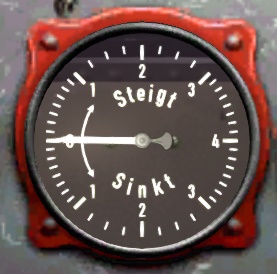|
As the age old saying goes, you need to walk before you can run, and sometimes learning to walk can be a challenge all by itself. Learning to fly in Aces High is something that requires some basic skill, plus some practical experience, but serves to set the basis for all the other things that you will learn. Without being able to take off, you can’t enjoy the action in the air. Without being able to land, you can’t enjoy the rewards of your skill. Flying is not actually a natural thing, most planes tend away from it because it
is a balancing act of forces that you never really control, simply organizing
them in a way that you are able to get airborne and remain in control. Your Cockpit GaugesThe cockpit layout of each aircraft in Aces High is slightly different, but the basic tools available on in the cockpit are the same in almost every aircraft (with a few exceptions). The following section gives a representative example of the Fw 190A-8 cockpit, one that is shared with other Focke Wulf variants and displays a typical selection and location of gauges. The key is to understand what the gauges are telling you. It’s like when you drive a car, you don’t want to have to look down and study the gauges while your attention should be in looking around outside the vehicle. Thus, you develop a process of scanning the gauges and quickly identifying what is important at a glance. - Each cockpit layout is slightly different, so that gauges may not be in the same position, although most aircraft with have an equivalent gauge. - The most important gauges tend to be positioned towards the center of the dash for easier reference. Primary Gauges – Gauges you will often look at and need to read at a glance
Flaps
Secondary Gauges
Engine Temperature
Oil Pressure
Manifold Pressure
Engine RPM
Sideslip indicator
Trim indicators
G-Force Meter
Some gauges may not be in easy view on some aircraft and you may have to look around the cockpit for them. Typically Primary flight gauges are clustered towards the center of the dashboard. Aircraft with multiple engines may have more than one gauge. Additional Dashboard IndicatorsLanding Gear Arrestor Hook There is no direct throttle indicator, though manifold pressure can give an indication of throttle setting. Non-Flight GaugesBeacon Ammo counters Why are the Gauges importantLater in this course, and in subsequent courses, you will find being able to read the gauges very important. You may find yourself trying to land, requiring a very limited speed range, or you may find yourself in the heat of combat, flying through a cloud where your only reference is to instruments. There are three (and sometimes four) tools you can use to control your aircraft in flight.
Visual cues tend to be limited, and can easily become disoriented or missed in violent maneuvers. Also, it can be difficult to determine, with accuracy, many flight parameters simply through visual and audio cues. Instruments provide accurate measurements but do require you to view them, which takes your attention away from what is happening around you. This is bad, so you need to be able to read instruments at a glance, so you can continue to be alert to events outside your aircraft. Some actions, like landing, require you to fly within established parameters that can only be determined using accurate gauge readings (like landing speeds, flap settings, sink rates) |

Cockpit Gauges
Flight Instruction
Courtesy of Zeno's Warbird Videos
 Altimeter
Altimeter Speedometer
Speedometer Climb/Decent Gauge
Climb/Decent Gauge Artificial Horizon
Artificial Horizon Fuel Gauge
Fuel Gauge





